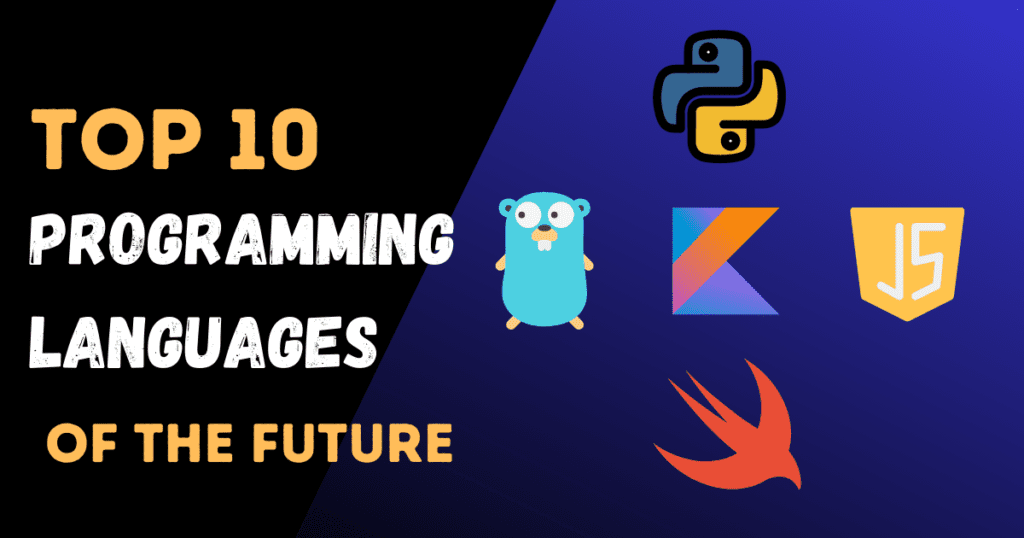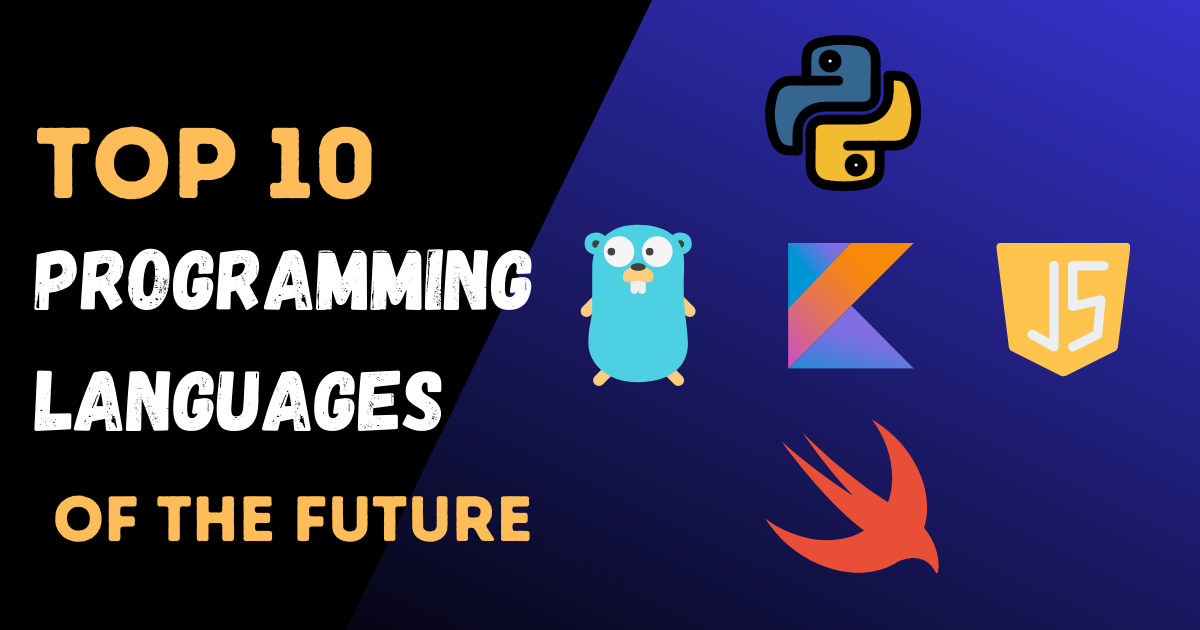The Top 10 Programming Languages of the Future
Programming languages are the backbone of modern technology, enabling developers to create innovative software and applications that shape our digital landscape. As technology continues to evolve, specific programming languages are emerging as frontrunners, poised to play a pivotal role in the future of coding. In this article, we’ll delve into the top 10 programming languages of the future that are likely to dominate the tech world.
As technology becomes increasingly intertwined with our daily lives, the demand for robust and efficient programming languages is soaring. Developers are constantly on the lookout for languages that offer enhanced functionality, speed, and security. The programming landscape is evolving, and specific languages are positioned to lead the way. Let’s dive into the article to find out the top 10 programming languages of the future.

Python: Versatility and Simplicity
Python, often regarded as a beginner-friendly language, has swiftly transitioned from a learning tool to a powerhouse for web development, data analysis, artificial intelligence, and more. It’s clean syntax and extensive libraries make it a go-to choice for projects of varying complexity.
In recent years, Python’s popularity has skyrocketed. Its ease of use and readability has made it a favourite among beginners, while its robustness and versatility have earned the respect of seasoned developers. Python’s extensive ecosystem of libraries and frameworks, such as Django and Flask, empowers developers to create web applications efficiently. Moreover, its compatibility with data analysis and machine learning libraries like Pandas, NumPy, and TensorFlow has solidified its position as a top choice for AI and data science projects. We can surely say that it is one of the top 10 programming languages of the future.
JavaScript: The Web’s Powerhouse
JavaScript is one of the top 10 programming languages of the future. It remains a staple in web development, enabling dynamic and interactive user experiences. With the rise of front-end frameworks like React and Vue.js, JavaScript’s significance is only set to grow.
JavaScript’s journey from being a simple scripting language for web pages to becoming a versatile tool for front-end and even back-end development is remarkable. The advent of Node.js has allowed developers to use JavaScript for server-side programming as well, further expanding its domain. As web applications become more intricate and user expectations continue to rise, JavaScript’s ability to create engaging and responsive interfaces ensures its relevance in the programming landscape.
Rust: Empowering System-Level Programming
Rust has captured the attention of developers with its focus on memory safety and performance. As the demand for efficient system-level programming increases, Rust’s capabilities make it a strong contender for the top 10 programming languages of the future.
In an era where security and efficiency are paramount, Rust stands out for its unique approach to memory management. By enforcing strict rules at compile time, Rust eliminates many common programming errors that lead to crashes and vulnerabilities. This makes it particularly suitable for systems programming, where reliability is crucial. Its ability to achieve near-native performance while ensuring memory safety positions Rust as a language of choice for projects that require both speed and security.
Go (Golang): Efficiency and Performance
Go, or Golang, has earned its stripes in concurrent and parallel programming. Its efficiency and simplicity make it a prime candidate for building scalable and high-performance applications.
Go’s design philosophy centres around simplicity and efficiency, making it an excellent option for applications that require handling a large number of concurrent tasks. Its lightweight goroutines and channels facilitate seamless concurrency, allowing developers to create responsive and scalable systems. Go’s performance and ability to build robust APIs have led to its adoption by tech giants like Google, Dropbox, and Docker.
Swift: A Bright Future for iOS Development
Swift has rapidly emerged as the preferred language for iOS and macOS app development. Its speed and safety features contribute to its popularity, indicating a promising future.
Since its introduction by Apple in 2014, Swift has gained traction for its modern syntax, safety features, and high-performance characteristics. Developers appreciate Swift’s readability and maintainability, which accelerate the app development process. Its ability to interact seamlessly with Objective-C code has facilitated the transition for developers from older iOS projects. With Apple’s continued investment in Swift and its open-source nature, the language is poised to remain a dominant force in the realm of mobile app development.
Kotlin: Enhancing Android App Development
Kotlin’s seamless interoperability with Java has propelled it to the forefront of Android app development. Its concise syntax and reduced boilerplate code have made it a hit among developers.
Kotlin’s arrival in the Android development scene brought a breath of fresh air. Its compatibility with existing Java codebases and modern features has led to rapid adoption by developers. Kotlin’s concise syntax reduces verbosity, resulting in cleaner and more expressive code. Its null safety features also contribute to more stable applications, reducing the likelihood of null pointer exceptions. As Google officially endorses Kotlin for Android app development, its significance in the programming world is undeniable and it creates its place in one of the top top 10 programming languages of the future.
TypeScript: The Strongly Typed JavaScript
TypeScript, a superset of JavaScript, offers static typing and improved tooling, resulting in more reliable codebases. Its adoption is on the rise, hinting at its significance in the programming landscape.
In the ever-evolving world of JavaScript, TypeScript has emerged as a powerful ally for building large-scale applications. By introducing static typing and interfaces, TypeScript enables developers to catch potential errors early in the development process. This results in more maintainable and robust code. TypeScript’s popularity is evident from its integration into popular frameworks like Angular and React, indicating its value in complex front-end projects. We can vouch for it to be a contender of one of the top 10 programming languages of the future.
Julia: Revolutionizing Scientific Computing
Julia’s high-performance capabilities have made it a game-changer in scientific computing and data analysis. Its speed and versatility are attracting researchers and analysts alike. We can assume that it is one of the top 10 programming languages of the future.
When it comes to intensive numerical and scientific computations, Julia shines brightly. Its just-in-time (JIT) compilation and efficient memory management contribute to impressive execution speeds. Julia’s flexible syntax and built-in mathematical functions make it a favourite among researchers and data scientists. With its ability to seamlessly interface with other programming languages and its growing package ecosystem, Julia is positioned to reshape the landscape of scientific computing.
R: Data Science and Analytics
R continues to be a dominant force in data science and analytics and it will be one of the top 10 programming languages of the future. With its rich ecosystem of packages and libraries, it remains a top choice for statisticians and data professionals.
R’s legacy in statistical computing is unrivalled. Its extensive collection of packages tailored for data analysis, visualization, and machine learning continues to attract a dedicated user base. R’s statistical modelling capabilities and data manipulation tools make it indispensable for researchers and analysts working with complex datasets. As the field of data science expands, R’s role in facilitating insights from data remains crucial.
C#: Windows Development Reimagined
C# has found its niche in Windows development, offering a powerful language for creating Windows applications and games. Its integration with the .NET framework secures its spot in the top 10 programming languages of the future.
C# has evolved to become the cornerstone of Windows development. Its seamless integration with the .NET framework empowers developers to build robust and feature-rich applications for the Windows ecosystem. With the advent of the Universal Windows Platform (UWP) and the cross-platform capabilities offered by .NET Core, C# is no longer limited to Windows alone. Its versatility, coupled with a thriving community and extensive libraries, ensures its continued relevance in the world of software development.
Conclusion
The programming landscape is in a constant state of flux, and staying ahead of the curve requires a keen understanding of emerging trends. The top 10 programming languages of the future highlighted in this article are poised to shape the future of technology. Whether you’re a novice developer or an experienced coder, embracing these languages could prove instrumental in your journey.
In conclusion, the world of programming languages is dynamic and ever-evolving. The top 10 programming languages of the future discussed here are positioned to shape the future of software development, catering to various domains and applications. Whether you’re building the next breakthrough app or delving into complex data analysis, choosing the right programming language can be a pivotal decision on your journey to success.
FAQs
Q1: Are these programming languages suitable for beginners?
A1: While some languages are more beginner-friendly than others, resources and tutorials are available to help learners of all levels.
Q2: How do I choose the correct language for my project?
A2: Consider the project’s requirements, your familiarity with the language, and its community support before making a decision.
Q3: Is Python still relevant for advanced projects?
A3: Absolutely. Python’s versatility and extensive libraries make it a powerful choice for advanced applications.
Q4: Which language is best for artificial intelligence?
A4: Python and Julia are often favoured for AI and machine learning projects due to their libraries and performance.
Q5: Can I use multiple languages in a single project?
A5: Yes, many projects incorporate multiple languages for different components, depending on their strengths.
Also Read: Stable Diffusion GTX 1650: Unveiling the Ultimate Gaming Marvel
